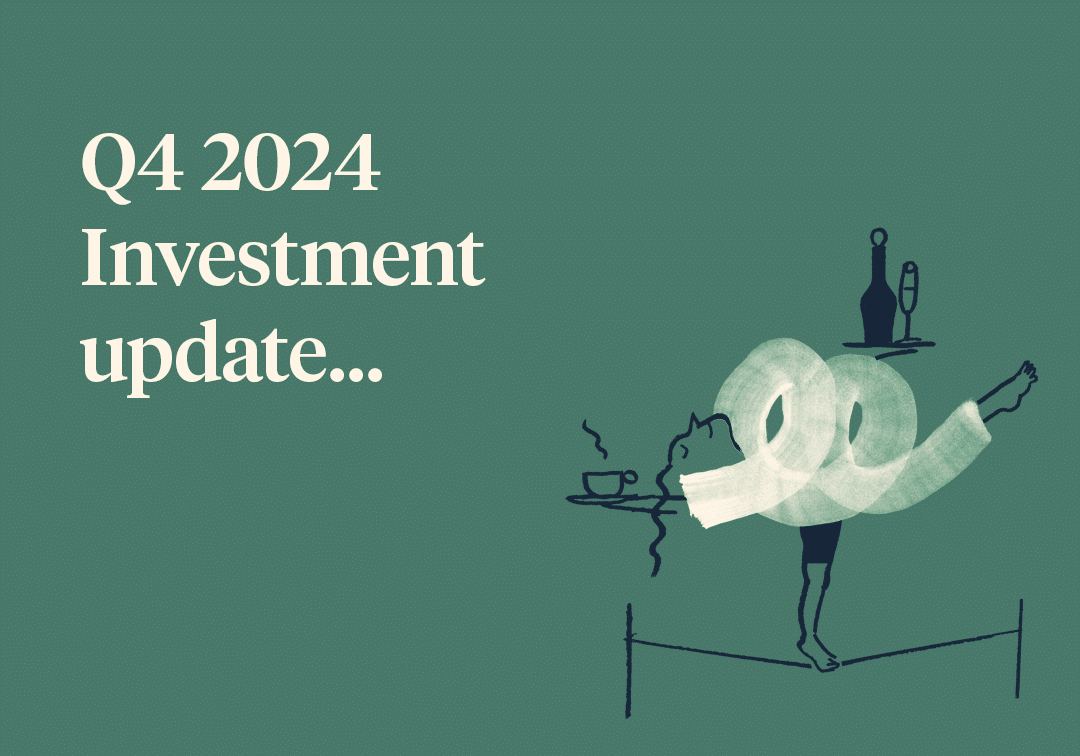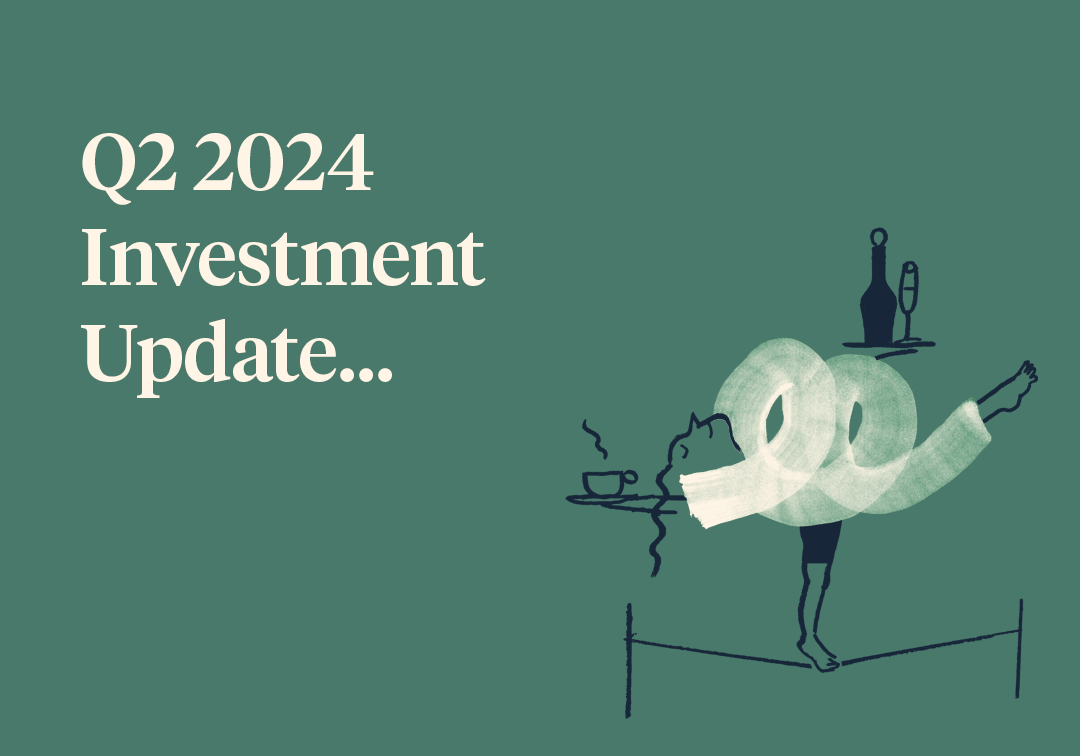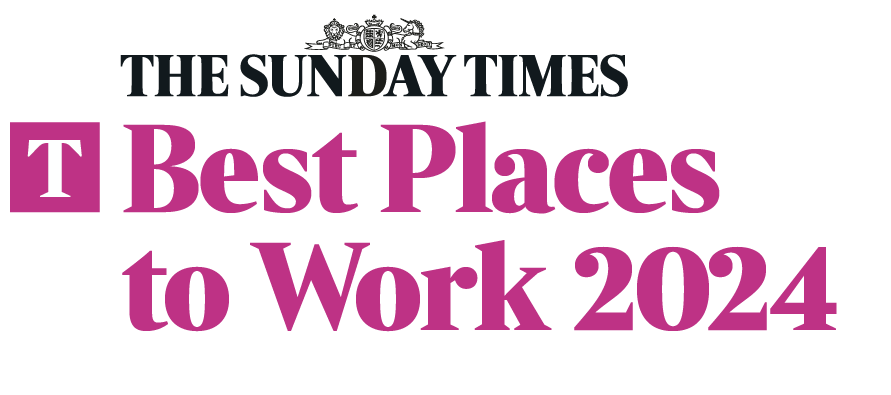Transcript
Jordan Gillies:
Hello and welcome to our Q3 2024 investment update. My name’s Jordan Gillies and I’m one of the Partners here at Saltus. And I’m joined by our Co-Chief Investment Officer, Charlie Ambler.
Charles Ambler:
Hi, thanks for having me.
Jordan Gillies:
So, it’s been a really choppy quarter, I would say, to say the least. It’s been quite volatile, but at the same time we’ve seen interest rates falling and we’ve seen markets rallying, and we’ve also of course got an election on the horizon. So, it’s been quite an interesting juxtaposition going on. So, Charlie, do you want to set the scene a little bit for us and just look back at what’s actually happened in the previous quarter in investment markets?
Charles Ambler:
Of course. I think if you just looked, as Jordan says, at the headline performance of some of the indices and equities in particular, you’d be forgiven for thinking it was quite a benign period. However, during the quarter we had two substantial market setups that actually even by two or three weeks later, markets were back to their starting positions. The first came at the start of August, it was more Japanese-centric. We saw the Japanese equity market fall 20% in two days, and the Japanese currency, the yen, rallied significantly versus the dollar. Both of these were tied to each other.
The reason for this was that the Japanese yen is used as a funding currency and what’s known as the yen carry trade. While it’s quite a technical trade, what it basically uses is a low-yielding or a currency with low interest rates like the yen. People sell that and people buy higher interest rate currencies, like in this case the dollar, the Mexican peso, and other emerging currencies. But in order to make a lot of money, you have to put a lot of leverage into it. And when this unwinds, it unwinds quite quickly. And we saw this happen at the start of August.
Jordan Gillies:
Just to come in there, why did that happen? Why did that unwind in that way? Was there anything that caused that?
Charles Ambler:
So, the two sides of that trade working based on the fact that the yen has to be a low interest-rate currency and the other currencies has to be a higher one. Now, the reason it unwound quite quickly was within about a week of each other, the Japanese central bank came out and said that there’d be hiking interest rates, a bit of a surprise to the markets. At the same time, it looked like the US were going to have to cut interest rates quicker. So those two factors combined to make a lot of highly-levered investors very worried about their positioning and cutting it quite significantly over the course of hours, minutes, and then ultimately days when it came to equities.
What we’ve seen later in the month though was the market stabilised, the volatility wasn’t just in Japanese equities. We saw significant selloffs in the UK, US, and European equities. However, by around about 10 days later, most of those markets had retouched where the starting points were with the only significant exception being Japan, which remained 3% to 4% under its starting weights.
Jordan Gillies:
However, it’s a bit of a lesson if you like I’d say. I remember being sat next to one of our advisors during that correction. Someone was calling up saying, “Should I be worried?” And he was saying that, “Absolutely not, we’d expect this type of volatility over the course of your investment period. And actually, we don’t think it’s indicative of anything broader or wider, so don’t overreact given that these things can happen in such a short period of time.”
Charles Ambler:
Yeah, of course. I mean it’s very hard in the middle of it all to not feel worried. There is nothing stopping it spreading wider apart from the fact that if your portfolio is highly diversified and you’re holding a lot of different asset classes in there, a single asset class taking 20% hits doesn’t mean too much overall. Of course, if you are fully exposed to the Japanese yen, you’ll have to be dealing with something slightly different, and this is what a lot of the traders are thinking at the start of the month. For us, we went into it slightly higher weight in Japan than others, but nothing significantly at risk. And overall, the month was a very positive one for us.
Jordan Gillies:
Okay. And what happened in the bond markets, Charlie? So, I know that was also something, sort of a little bit of volatility over the last quarter.
Charles Ambler:
So broadly, bond markets have been very positive and that goes back to April, May time this year. This is when central banks globally started cutting interest rates. What we’ve seen since is as a phenomenon that people refer to as one month is just one month, and it’s a phrase that has appeared to try and stop people getting too ahead of themselves every time an inflation data point comes out or a jobs data point comes out, these are very backwards looking metrics and there are obviously a lot of people looking at expectations on these. When the job report came out in August and unemployment was looking a little bit weak or, sorry, the economy was looking a little bit weak, it was off the back of the central bank, the Fed having decided not to cut interest rates just before that.
Now, those two combined to effectively suggest that maybe a recession is on the cards and suddenly bonds are rallying, equity markets are falling, and the overall feeling is there. It was one of nerves. Now, fast-forward one month and the Federal Reserve has decided to cut 50 basis points, which is double the 25 basis points step that people see as standard. And then only a week after that, you get a very strong jobs report. Suddenly, you’re looking at these coordinated interest rate cuts and the strong economy type situation, and it’s only been one month. And the truth is that actually the average of those two reports is fairly benign, but people are trading off a single month’s data point that’s very backwards looking and trying to predict how things are going to be in the future with it.
Jordan Gillies:
Okay. And so, we’re much more long-term investors for our clients rather than trading on monthly data per se. So, what in that kind of slightly noisy context, benign period as you refer to it, what were we actually doing in portfolios over the last quarter?
Charles Ambler:
Yeah. So, there’s a couple of things that we’ve been focusing on. The first one is that actually what we’re looking at is not a bad period for investments. We see interest rate cutting cycles in the face of stronger economies as a positive. We appreciate that they don’t typically go hand in hand, and it’s one of the reasons why equity markets are priced quite high at the moment because people feel that the underlying economy isn’t too bad. The Federal Reserve and other central banks both have some capacity to cut interest rates from here and inflation is abating and becoming less of an issue. Now, obviously that is subject to change where we just see a sort of re-inflation-type spike, we could have another situation where central banks have their hands forced and interest rate cuts are suddenly off the table. But these numbers are… Inflation prints don’t come around quickly, they move much more slowly. They add one month on one month. And the current outlook is one of cautious positivity.
Inside portfolios, we’ve been looking more towards the bond markets. They’re a good starting valuation subject to there not being a major re-acceleration of economic growth. We feel that the rising yields and falling prices offer a good opportunity to purchase a bit more, and that’s what we’ve been doing around the edges. Equally, in equity markets, we believe there’s the scope for this sort of broad rally to broaden out. We’ve seen over this year that equity markets have been led very, very aggressively by seven names, the Magnificent Seven. Really, it’s more like four or five and in some cases it doesn’t look like it’s just one. But there is scope for this to broaden out to the wider economy, especially as we see coordinated cuts coming in around the world. And it’s just easing that sort of pressure off consumer, off small caps funding, off debt levels or highly indebted companies. All the ones that have lagged these Magnificent Seven have the opportunity to catch up a little bit more now in what is a fairly benign environment.
Jordan Gillies:
So, is that we’ve been removing some exposure to those types of tech indices in our selections or how have we been doing that exactly?
Charles Ambler:
Yeah. So, one of the main positions that we’ve been adding to is the S&P Equal Weights. It’s a very low-cost way to get access to a highly diversified index and one that really captures a broad economic strength in America, a lot more than the seven tech companies, and the AI revolution being one of real corporate growth rather than just hyperbole that we’re seeing at the moment. Our concerns are around the fact that a lot of good news has been priced into those sorts of seven stocks, and that’s good news looking quite substantially further out ahead. So, there’s a high hurdle rate for those to be hitting. There’s nothing to stop doing that, but you’ve seen in the last sort of quarters corporate earnings come out. And even though they announced even better margins and higher profits, the stocks sell off slightly because investors are expecting a lot.
Jordan Gillies:
Okay. And in a world as well where we’re kind of cautiously optimistic, if you like that famous phrase, just to kind of jump back to the fact that you also mentioned that we’ve been increasing our exposure to some fixed interest positions, often those two things, fixed interest are often viewed as more of a safe haven type asset. So can you just explain that in layman’s terms as to how those two thoughts are working together and why we’re looking at increasing some exposure to the bond market?
Charles Ambler:
Yeah, of course. I mean I think one of the best ways to explain it is the fact that we don’t have a crystal ball. Whilst we invest for our base case, we obviously have to take on positions that will help if we’re wrong. Now, a lot of the time that could be fixed interest, a lot of the time it might be something else, and it’s very nice to have a lot of tools in your sort of armoury in order to diversify. What we’ve seen more recently is with inflation coming down and with the bond market having repriced a lot lower and nicer starting valuations, there is a lot more scope for equities and bonds to move in a negative correlated way.
So, if one’s going up, the other’s going down and vice versa, they can offset each other based on these one-month trading patterns and overall, growth concerns that will not be solved in the next month or two, people won’t know which environment we were in until probably we’re through it. However, they do offer a nice risk adjusted return. And especially at the lower end of portfolios, lower risk portfolios, we’ve seen interest rates getting up to 5%. That’s quite a lot higher than inflation and we know a lot of our investors are out there just trying to beat inflation by 1% or 2% per year. So, if we can lock in real yields of two, and that’s a sort of normal yield or nominal yield minus whatever the inflation number is, that is a very attractive return for someone in effectively risk-free government bonds.
Now, if we rewind back to 2021 coming out of COVID, that number was more like minus one, maybe even minus one and a half. So, a low risk investor could invest in government bonds, but they’re almost guaranteed to lose money after inflation over that time period. So that’s part of the reason why we’re looking more in the bond market because we feel that as a low risk and asset class, they’re back to their starting point of where they can be useful for us having been something that we would struggle to invest with on a valuation basis for a number of years.
Jordan Gillies:
Okay. So, they’re really helpful at the lower end of the risk spectrum, but also really useful during volatile periods to help eke out a steady return with some stability when we’ve got exposure to equities as well?
Charles Ambler:
Yeah, absolutely.
Jordan Gillies:
Okay. And so, then you said that you don’t have a crystal ball, but I’m about to ask you to get your crystal ball out, Charlie. So obviously, there’s been a lot of talk about elections worldwide, obviously the US election and the UK election for us at home. So, are you concerned about the outlook in this context? I know you said previously and today at the moment you’re cautiously optimistic, but do you think that’s going to remain the case over the course of the next quarter or six months or so?
Charles Ambler:
Yeah. I mean, I think the UK budget and the US election are probably the two big political talking points coming up in the next few weeks. I think from a UK standpoint, we are global investors, we don’t have a huge allocation in the UK generally, and I say this hesitantly after the last budget caused trust-related sell off in bonds. Generally, we feel that politics and elections and budgets tend to create a lot of noise and volatility. They don’t typically drive markets too much. Now, that’s not to say that there can’t be good policies that push through to growth or bad policies in the case of something like tariffs, but what we tend to see is that actually people trade a lot of the rumours and the truth tends to be something a fair bit more benign.
Now, there is a tail risk with regards to the US election in the fact that Donald Trump is being very vocal about tariffs. Firstly, as you mentioned, having a crystal ball, I have no idea who’s going to win the US election and a lot of the latest polls suggest it’s quite 50/50. On top of that, for someone to get in, they also have to win both the Senate and Congress in order to have a real meaningful ability to drive change. So, I think the odds of that happening and it being a sort of a red sweep is low.
On top of that, what we saw with Donald Trump’s first term is that he is a man who likes to use the S&P 500 as a metric for how well the economy’s doing. It’s one way of measuring it, certainly not the way that most people on the street would, but he was very vocal every time it hit new highs. And I’m sure there’ll be plenty of advisors telling him that a lot of his tariffs and his sort of anti-trade and protectionist policies would be very damaging for stuff like that. So, I would be surprised if it’s not more of a tool he’s using to get into the White House and it would be less of a tool he uses after he is in the White House. So again, not something that’s wholly concerning us at the moment, but it is something that we have taken steps to increase diversification when there is such a wide range of outcomes on the table.
Jordan Gillies:
And what about interest rates? Everyone talks about it now, kind of inflation interest rates. Obviously, it looks like a better picture, but are the Fed going to be extremely hawkish on interest rate cuts, for example going forward? And we see lots of opportunity there. What’s your view on what’s going to happen with interest rates in the cycle?
Charles Ambler:
So hawkish would mean less cuts, dovish tends to mean more from here. Our concern is more surrounding the fact that the market is predicting quite a lot of interest rate cuts already. That has been tapered back a bit after this September jobs number, but it is something that we’re very focused on. The fact that inflation has come down to a sort of more longer-term range, maybe at the top edge of that range, but forward-looking inflation and data’s mixed, not very concerning, means that it gives central banks, especially the Fed, a little bit more flexibility. And that flexibility is nice, they in the past had their hands tied a little bit in the sense that until inflation came down, no matter how the economy was doing, they were going to have to keep interest rates high.
If we see economic weakness from here, we would likely see more cuts priced in. And if we see economic strength, we would likely see less cuts priced in. And that is a much more normal environment for us to be investing in compared to double-digit inflation and questionable growth rates, which are being led by a few choice stocks. What’s more appealing at the moment is the fact that there is a sort of synchronised cutting cycle appearing around the world. A lot of the developed markets and even emerging markets that went first are in this cutting cycle. And that typically drives global growth, you see an uptick in trade barring in the tariffs, and I think we could be in a period for a slightly more traditional economic expansion rather than one that’s aggressively led by the Magnificent Seven.
Jordan Gillies:
So, sort of steady as she goes for a summary, is that fair?
Charles Ambler:
Yeah, I think so. So, the big problem with interest rates is that no one really knows when or how much impact they’re going to have on the economy. And not too long ago we were hiking and we’ve been holding higher interest rates for quite a while. So, there is always the fact that we might not have seen the full impact of this hiking cycle and there might still be some sort of dampening to come through, but it feels like we have started the cutting cycle from a position of strength rather than one of aggressive weakness that typically is when you start seeing cuts.
Jordan Gillies:
Okay. So cautiously optimistic for the future as well, Charlie, is that fair to say?
Charles Ambler:
I feel that phrase has been said a lot, but yes.
Jordan Gillies:
Excellent. All right. Well, look, thank you so much for your time and thank you as well to all our listeners. We look forward to seeing you at our next quarterly update.
Do you need help managing your investments?
Our team can recommend an investment strategy to meet your financial objectives and give you peace of mind that your investments are in good hands. Get in touch to discuss how we can help you.

Article sources
Editorial policy
All authors have considerable industry expertise and specific knowledge on any given topic. All pieces are reviewed by an additional qualified financial specialist to ensure objectivity and accuracy to the best of our ability. All reviewer’s qualifications are from leading industry bodies. Where possible we use primary sources to support our work. These can include white papers, government sources and data, original reports and interviews or articles from other industry experts. We also reference research from other reputable financial planning and investment management firms where appropriate.
The views expressed in this article are those of the Saltus Asset Management team. These typically relate to the core Saltus portfolios. We aim to implement our views across all Saltus strategies, but we must work within each portfolio’s specific objectives and restrictions. This means our views can be implemented more comprehensively in some mandates than others. If your funds are not within a Saltus portfolio and you would like more information, please get in touch with your adviser. Saltus Asset Management is a trading name of Saltus Partners LLP which is authorised and regulated by the Financial Conduct Authority. Information is correct to the best of our understanding as at the date of publication. Nothing within this content is intended as, or can be relied upon, as financial advice. Capital is at risk. You may get back less than you invested. Tax rules may change and the value of tax reliefs depends on your individual circumstances.
Related blog posts
About Saltus?
Find out more about our award-winning wealth management services…
Winner
Investment Performance: Cautious Portfolios
Winner
Top 100 Fund Selectors 2024
Winner
Best Places to Work 2024
Winner
Best Financial Advisers to Work For
£8bn+
assets under advice
20
years working with clients
350+
employees
97%
client retention rate





